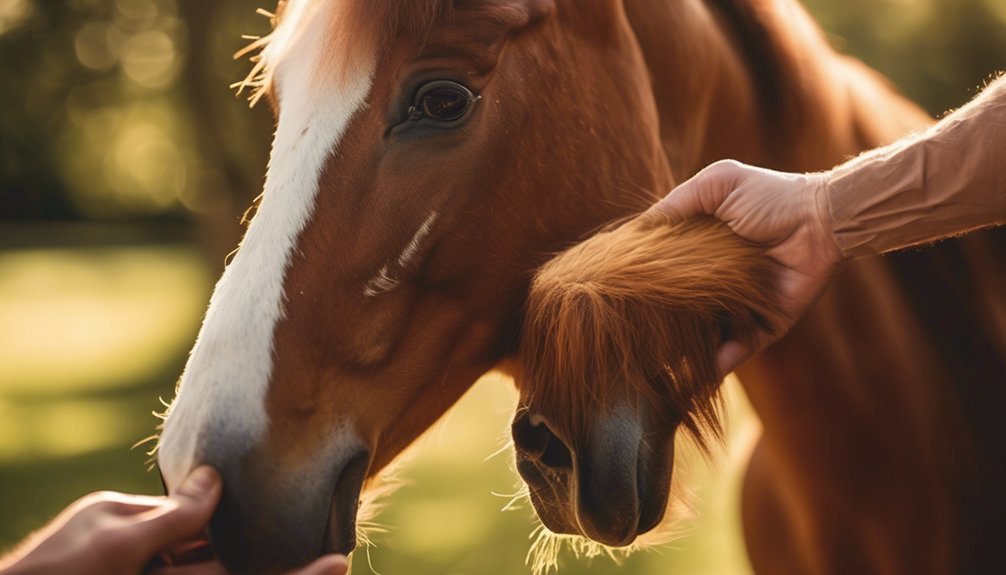
When you're grooming a horse with a thick coat, it's essential to understand the specific needs of their fur. Using the right tools and techniques can make a significant difference in maintaining their coat's health and appearance. You'll want to focus on effective brushing methods and proper care during shedding season. As you navigate these grooming practices, consider how they can also enhance your relationship with your horse. What strategies will you implement to achieve the best results?
Key Takeaways
- Use sturdy grooming brushes, like rubber curry combs, to effectively loosen dirt and debris from thick coats.
- Brush in sections, starting with a curry comb, then stiff-bristled brushes, and finish with a soft brush for shine.
- During shedding season, employ shedding blades or rubber curry combs to manage loose hair and promote circulation.
- Ensure regular grooming with coat nutrition rich in vitamins and omega fatty acids to support a healthy coat.
- Bathe with warm water and gentle, horse-specific shampoos to maintain skin health and strengthen the bond during grooming.
Understanding Your Horse's Coat Type

When it comes to grooming your horse, understanding its coat type is essential for effective care. Each horse's coat has unique characteristics, whether it's smooth, coarse, or a combination.
Take time to observe how your horse's coat responds to changes in weather, as this can influence maintenance routines. For example, a thicker coat may trap dirt and moisture, requiring more frequent brushing to prevent skin issues.
Pay attention to seasonal changes; a horse might shed heavily in spring, so adjust your grooming schedule accordingly. Using the right techniques, like currying and slicking, can enhance the coat's natural shine and health.
Ultimately, knowing your horse's coat type helps you provide the tailored care they deserve, fostering a deeper bond between you two.
Essential Grooming Tools for Thick Coats
Knowing your horse's coat type sets the stage for selecting the right grooming tools, especially for those with thick coats that require extra attention.
Start with sturdy grooming brushes, like a rubber curry comb, to loosen dirt and debris. Follow up with a stiff-bristled brush to remove the loosened particles effectively.
For a finishing touch, a soft body brush will help smooth the coat and add shine. Don't forget to include quality coat conditioners, which can hydrate and nourish your horse's thick fur, making it easier to manage.
These tools not only keep your horse looking its best but also strengthen your bond as you care for them. Invest in the right tools, and grooming will become a rewarding experience for both of you.
Techniques for Effective Brushing

Effective brushing techniques can make all the difference in your grooming routine, especially for horses with thick coats. Start by using a curry comb to loosen dirt and debris, working in circular motions.
Follow up with a stiff-bristled brush to remove the loosened particles, applying firm pressure but being gentle on sensitive areas. Finally, use a soft brush for a finishing touch, enhancing your horse's coat shine.
Here are three essential tips for effective brushing:
- Brush in the direction of hair growth to avoid discomfort.
- Divide the coat into sections to ensure thorough coverage.
- Take your time; building a connection during grooming fosters trust.
These brushing techniques are crucial for maintaining your horse's coat health and overall well-being.
Managing Shedding Season
As spring approaches, many horse owners find themselves facing the challenge of managing shedding season.
You'll notice increased shedding frequency as your horse transitions from their thick winter coat to a lighter summer one. To make this process smoother, prioritize coat nutrition. Ensure your horse's diet is rich in vitamins and minerals, particularly omega fatty acids, which support healthy skin and coat.
Regular grooming is essential; it stimulates the skin, promotes blood circulation, and helps remove loose hair. Use a shedding blade or rubber curry comb, and don't forget to check for any skin irritations.
Staying consistent with grooming not only eases the shedding process but also strengthens your bond with your horse, turning this seasonal challenge into an enjoyable routine.
Bathing Tips for Thick-Coated Horses

Bathing thick-coated horses can be a refreshing experience for both you and your equine friend, especially as warmer weather arrives.
To make the process enjoyable, pay close attention to bath temperature and shampoo selection.
Here are some tips to ensure a successful bath:
- Choose warm water: It relaxes your horse and helps loosen dirt without causing discomfort.
- Select a gentle shampoo: Opt for a mild, horse-specific formula to avoid skin irritation.
- Rinse thoroughly: Make sure to remove all soap to prevent residue that could irritate the skin.
As you lather and rinse, take your time to bond with your horse.
This moment can strengthen your connection while keeping your horse clean and comfortable.
Maintaining Skin Health Underneath the Coat
To keep your horse's skin healthy beneath its coat, you need to adopt a proactive grooming routine. Start by brushing regularly to remove dirt, debris, and dead hair, allowing the skin to breathe.
Use a soft curry comb to stimulate circulation and promote skin hydration. Pay attention to areas prone to irritation, like the girth and saddle spots.
Incorporate quality coat nutrition into your horse's diet—omega fatty acids, vitamins, and minerals can significantly enhance skin condition and coat luster.
Additionally, consider using a moisturizing spray designed for horses to maintain hydration, especially in dry conditions.
Seasonal Grooming Considerations

While each season brings unique challenges and changes for horse grooming, adapting your routine can ensure your horse stays comfortable and healthy year-round.
Seasonal transitions affect your horse's coat, and climate impacts can alter your grooming needs.
Consider these grooming tips for each season:
- Spring: Focus on shedding tools to manage the thick coat as it begins to thin out.
- Summer: Keep your horse cool and comfortable by using lightweight grooming tools and regular baths.
- Winter: Use a good curry comb to stimulate circulation and maintain skin health under the dense coat.
Frequently Asked Questions
How Often Should I Groom My Thick-Coated Horse?
You should groom your thick-coated horse at least two to three times a week for optimal coat maintenance. Regular grooming frequency keeps the coat healthy, reduces dirt buildup, and strengthens your bond with your horse.
Can I Use Human Hair Products on My Horse?
Why would you risk your horse's health? Human hair products can irritate their skin and disrupt natural oils. Stick to equine-specific grooming products for effective horse coat care, ensuring your horse stays happy and healthy.
What Are Signs of Skin Issues Under a Thick Coat?
When inspecting your horse's coat, look for signs of skin irritations like redness, swelling, or scabs. Pay attention to unusual behaviors, such as excessive itching or sensitivity, as these can indicate underlying skin issues.
Are There Specific Supplements for Thick-Coated Horses?
Ever wondered how supplements can enhance your horse's coat? Specific supplements can aid in coat maintenance, providing essential nutrients that promote healthy growth and shine. Consider omega-3 fatty acids and biotin for optimal supplement benefits.
How Can I Help My Horse Tolerate Grooming Sessions?
To help your horse tolerate grooming sessions, use gentle grooming techniques and introduce positive reinforcement. Reward them with treats or praise during and after grooming, creating a relaxed environment that fosters trust and comfort between you both.
Conclusion
In the grand scheme of horse care, you might think grooming a thick-coated horse is merely a chore. Ironically, it's one of the best ways to deepen your bond, enhance your horse's health, and even find a bit of peace in your busy day. So, while you tackle those stubborn clumps of hair and dirt, remember: each stroke of your brush isn't just about appearance; it's a step toward a happier, healthier partnership with your equine friend.





